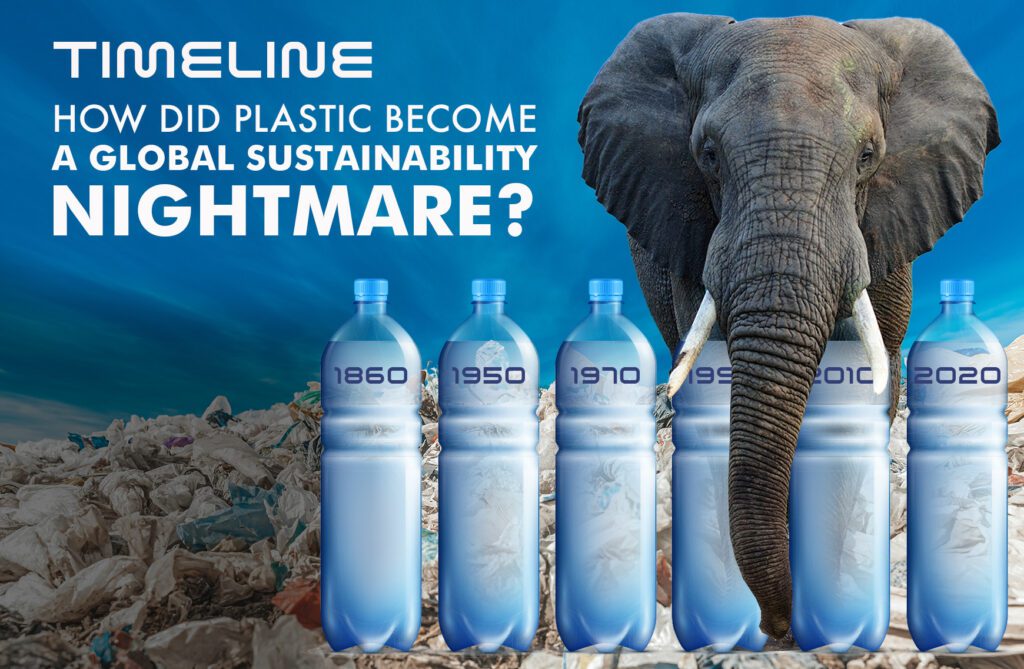A Timeline of Plastic Pollution. From wonder solution to a global sustainability nightmare

Did you know that plastic was invented to save the lives of elephants? In 1869 the first synthetic polymer was created and so plastic was born. John Wesley Hyatt responded to a New York firm’s offer of $10,000 in exchange for an alternative to ivory. So how did this wonderful new alternative, that saved the lives of over 20,000 elephants each year, become a global sustainability nightmare?
1950: Plastic entered the mainstream
There was a huge shift in plastic consumption in 1950 when it was introduced to the food sector. Historically customers would eat out in restaurants with ceramic plates and metal cutlery with linen tablecloths and napkins. The introduction of plastic into this environment allowed restaurants to move into a new era of flexibility, allowing for takeaways and business expansion but spelling the start of plastic entering day-to-day life.
1970: Single-use plastic bags
While consumers weren’t too convinced by the single-use plastic bag when it first arrived on the scene in 1970, it soon entered the mainstream. Little did the inventor or producer of the single-use plastic bag know that plastic would become one of the most significant burdens on the planet in years to come- encouraged by consumers’ love for the convenient, single-use plastic bag.
1990: A stark realisation
By 1990 researchers were discovering that plastic was polluting our oceans and worse than that 60-80% of that plastic was going nowhere fast. While plastic was developed with wildlife in mind, by the 90s it was clear that it was doing more than enough damage to wildlife on its own. Plastic pollution in our oceans was damaging sea life and the environment at the same time.
2010: Growing Awareness
As awareness of the negative effects of plastic on our environment grew, plastic finally began to see a decline in use by 2010. Whilst the issue with plastic was widely known before this, this is when we saw an active effort being made to use alternatives. Single-use plastics were of course targeted first, their use didn’t fit into the circular economy and was seen to be causing the worst pollution. Did you know Tesco bought over 600 million single-use plastic bags in 2016 alone?
2020: Innovation
By 2020 we’re really starting to get somewhere with plastic alternatives. We’re starting to see some exciting new innovations coming through from biodegradable bottles to liquid packaging solutions and alternative materials made from biowaste such as starch-based polymers. The restaurant and fast food industries have long made the switch to cardboard and sustainable packaging and we’re seeing everyone making a conscious effort to go green.
What next?
So, what next? As we see more and more businesses, governments, and organisations making pledges to make better, more environmentally friendly choices we can but hope that we’re doing enough to reverse the damage already done. Taking little steps is better than no steps and we supply a fantastic range of branded merchandise that can help promote your brand and the planet. Use our sustainability checklist to ensure our eco-friendly branded merchandise meets your own green goals and take peace of mind from our full supply chain traceability.
Whilst we’re not going to deny that we still supply plastic products, we’re working towards meeting our own sustainability goals. We source our products from manufacturers who rapidly support initiatives that actively stop plastic pollution, we’re Sedex members, and our offices use reusable energy. We aim to be fully carbon neutral by 2050, and we’re making strides to get there.
Start your eco-friendly journey with Streamline, request your own eco-audit today.
